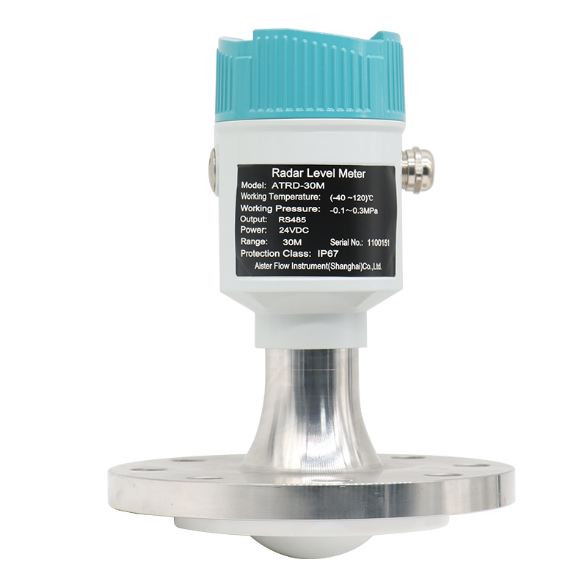Key points of design for the first use of radar level meter
2023-12-28
Radar Level Meter is a device commonly used to measure the level of liquid or solid materials. The following are the design points of the radar level meter when it is first used:

Selection and applicability: Select the appropriate radar level gauge model according to the specific application scenario. Considering the nature of the liquid or material, temperature, pressure and other factors, to ensure that the selected radar level meter can meet the actual needs.
Installation location: Select a suitable location when installing the radar level gauge. Ensure that the radar antenna has a clear field of view, and avoid any object blocking or interference. At the same time, consider avoiding environments with large vibrations, vibrations, and temperature changes.
Calibration and commissioning: Careful calibration and commissioning before initial use. Calibration involves setting the appropriate level zero and full scale values. Ensure accurate and reliable measurement results of radar level gauge.
Power supply and wiring: Ensure that the radar level meter has a stable and reliable power supply. Connect the cable of the radar level gauge correctly and ensure that the quality and length of the cable meet the requirements.
Environmental adaptability: Consider the environmental adaptability of the radar level gauge. If used in harsh environments, special designs such as explosion-proof, corrosion-proof or dustproof may be required.
Communication interface Settings: If the radar level meter has a communication interface, ensure that the communication parameters are correctly set for effective data exchange with the monitoring system or data acquisition equipment.
Safety measures: Follow relevant safety procedures and standards. Ensure that the installation and use of radar level gauges do not pose a danger to personnel and equipment.
Maintenance Schedule: Develop a regular maintenance schedule that includes cleaning, calibration, and inspection of the various components of the equipment. Regular maintenance can ensure the long-term stable operation of the radar level gauge.
Train operators: Train operators to understand the basic principles, use methods and maintenance points of radar level meters to ensure correct operation and timely handling of possible problems.
Records and documents: Record the installation process, calibration data, maintenance records and other information of the radar level gauge. Create detailed documentation for future reference and traceability.
Through the above design points, it can be ensured that the radar level meter can operate stably and accurately when it is first used, and maintain reliability in long-term use. More information can be found at Aister Instrument.

Selection and applicability: Select the appropriate radar level gauge model according to the specific application scenario. Considering the nature of the liquid or material, temperature, pressure and other factors, to ensure that the selected radar level meter can meet the actual needs.
Installation location: Select a suitable location when installing the radar level gauge. Ensure that the radar antenna has a clear field of view, and avoid any object blocking or interference. At the same time, consider avoiding environments with large vibrations, vibrations, and temperature changes.
Calibration and commissioning: Careful calibration and commissioning before initial use. Calibration involves setting the appropriate level zero and full scale values. Ensure accurate and reliable measurement results of radar level gauge.
Power supply and wiring: Ensure that the radar level meter has a stable and reliable power supply. Connect the cable of the radar level gauge correctly and ensure that the quality and length of the cable meet the requirements.
Environmental adaptability: Consider the environmental adaptability of the radar level gauge. If used in harsh environments, special designs such as explosion-proof, corrosion-proof or dustproof may be required.
Communication interface Settings: If the radar level meter has a communication interface, ensure that the communication parameters are correctly set for effective data exchange with the monitoring system or data acquisition equipment.
Safety measures: Follow relevant safety procedures and standards. Ensure that the installation and use of radar level gauges do not pose a danger to personnel and equipment.
Maintenance Schedule: Develop a regular maintenance schedule that includes cleaning, calibration, and inspection of the various components of the equipment. Regular maintenance can ensure the long-term stable operation of the radar level gauge.
Train operators: Train operators to understand the basic principles, use methods and maintenance points of radar level meters to ensure correct operation and timely handling of possible problems.
Records and documents: Record the installation process, calibration data, maintenance records and other information of the radar level gauge. Create detailed documentation for future reference and traceability.
Through the above design points, it can be ensured that the radar level meter can operate stably and accurately when it is first used, and maintain reliability in long-term use. More information can be found at Aister Instrument.
Share To:
News
- Why is the thermal gas mass flowmeter not affected by pressure strength and temperature?
- What to do when a thermal gas mass flow meter fails?
- How are thermal gas mass flow meters used? What are the applications?
- Under what circumstances is the gas measurement need to be regulated compensated vortex flowmeter
- Why Is The Aister Thermal Gas Mass Flowmeter So Popular ?
- Gas turbine flowmeter manufacturers explain their main advantages in measurement
- Gas turbine flowmeter manufacturer Aister instrument field experience summary
- Aister Instrument Empowerment Conference








